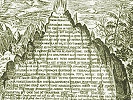
Sacred Texts Gnosticism and Hermetica Index Previous Next
Buy this Book at Amazon.com


Thrice-Greatest Hermes, Vol. 3, by G.R.S. Mead, [1906], at sacred-texts.com
(Title from Patrizzi (p. 38b); followed by: “To the Same Tat.”
Text: Stob., Phys., viii. 41, under heading: “Of Hermes from the [Sermons] to Tat”; G. p. 93; M. i. 64.
Ménard, Livre IV., No. v. of “Fragments from the Books of Hermes to his Son Tat,” p. 241.)
1. Now to find out concerning the three times; for they are neither by themselves, nor [yet] are they at-oned; and [yet] again they are at-oned, and by themselves [as well].
For should’st thou think the present is without the past, it can’t be present unless it has become already past. 1
For from the past the present comes, and from the present future goes.
But if we have to scrutinize more closely, thus let us argue:
2. Past time doth pass into no longer being
this, 1 and future [time] doth not exist, in its not being present; nay, present even is not present, in its continuing.
Time, then, which stands not [steady] (ἕστηκε), but which is on the turn, without a central point at which to stop,—how can it be called in-stant (ἐνεστώς), 2 seeing even that it hath no power to stand (ἑστάναι)?
Again, past joining present, and present [joining] future, they [thus] are one; for they are not without them 3 in their sameness, and their oneness, and their continuity.
Thus, [then], time’s both continuous and discontinuous, though one and the same [time].
28:1 That is, apparently, you cannot think of the present until it is already past.
29:1 That is, apparently, “present.”
29:2 The usual term in Greek for “present,” but I have here translated it by “instant” in order to keep the word-play, which would otherwise entirely vanish in translation.
29:3 That is, apparently, any one without the other two, or any two without the other one.